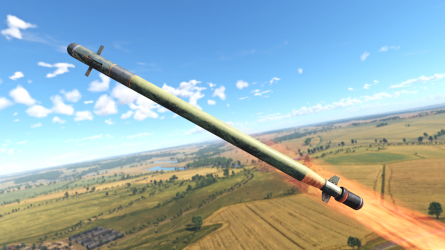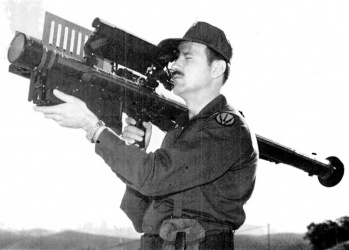Difference between revisions of "FIM-92 Stinger"
(→Pros and cons) (Tag: Visual edit) |
(Description etc added) |
||
| Line 3: | Line 3: | ||
== Description == | == Description == | ||
<!-- ''Write an introduction to the article in 2-3 small paragraphs. Briefly tell us about the history of the development and combat using the weaponry and also about its features. Compile a list of air, ground, or naval vehicles that feature this weapon system in the game.'' --> | <!-- ''Write an introduction to the article in 2-3 small paragraphs. Briefly tell us about the history of the development and combat using the weaponry and also about its features. Compile a list of air, ground, or naval vehicles that feature this weapon system in the game.'' --> | ||
| − | The '''{{PAGENAME}}''' is an American infrared homing surface-to-air missile. It exists in two variants: FIM-92E and FIM-92K, and was introduced in [[Update "Wind of Change"]]. It is also known as the "'''Fliegerfaust 2 Stinger'''" in German service. | + | The '''{{PAGENAME}}''' is an American infrared homing surface-to-air missile. It exists in two variants: FIM-92E and FIM-92K, and was introduced in [[Update "Wind of Change"]]. It is also known as the "'''Fliegerfaust 2 Stinger'''" in German service. The Stinger is what is commonly known as a MANPADS missile - short for MAN-Portable Air Defense System - and was developed to be portable and self-reliant. As such, the missile comes equipped with an Infra-Red Counter-Countermeasure (IRCCM) seeker, meaning it can reject enemy flares with devastating accuracy and home in straight towards an enemy aircraft. While lacking in range compared to larger, bulkier SAM systems such as the [[Tor-M1]] or [[ADATS]], the significantly more discreet hulls and moderate range of 6 km means just as in real life these missiles can pose a threat at a moment's notice. |
=== Vehicles equipped with this weapon === | === Vehicles equipped with this weapon === | ||
| Line 15: | Line 15: | ||
== General info == | == General info == | ||
<!--''Tell us about the tactical and technical characteristics of the missile.''--> | <!--''Tell us about the tactical and technical characteristics of the missile.''--> | ||
| + | |||
| + | The FIM-92E and 92K are identical outside of the 92K having a proximity fuse of 1 meter, noticeably increasing its lethality in cases of near misses. | ||
{| class="wikitable" style="display:inline-table;text-align:center" | {| class="wikitable" style="display:inline-table;text-align:center" | ||
| Line 82: | Line 84: | ||
=== Effective damage === | === Effective damage === | ||
| − | ''Describe the type of damage produced by this type of missile (high explosive, splash damage, etc.)'' | + | <!-- ''Describe the type of damage produced by this type of missile (high explosive, splash damage, etc.)'' --> |
| − | + | The Stinger produces somewhat low shrapnel. This is not to say the missile lacks lethality as some people like to claim, but as it is a man-portable missile its warhead simply isn't as large as conventional SAMs. A hit will usually prove fatal to almost all aircraft, but more resilient aircraft such as the [[Su-25 (Family)]] may occasionally survive a direct hit. It is however to be noted that often when a Su-25 is hit the aircraft itself may ''seem'' fine, but usually suffers irreparable damage to the control wires or fuel tanks in the process, so regardless of any situation firing off more than 2 Stingers at any aircraft is inadvisable. | |
=== Comparison with analogues === | === Comparison with analogues === | ||
| − | ''Give a comparative description of missiles that have firepower equal to this weapon.'' | + | <!-- ''Give a comparative description of missiles that have firepower equal to this weapon.'' --> |
| − | + | The Stinger is similar to its contemporaries which include but are not limited to the [[9M39 Igla | 9M39]], [[Type 91]], and [[Mistral SATCP | Mistral]] MANPADS class missiles. The 9M39 is roughly equivalent to the Stinger with a similar explosive warhead content and no proximity fuse like the FIM-92E, flying at a slightly slower speed and with a worse all aspect lock range, whereas the Mistral is closer to being a direct upgrade instead with more Gs pulled, a faster firing speed and a warhead with three times more filler. All in all, the Stinger is adequately balanced between practicality and efficiency. | |
== Usage in battles == | == Usage in battles == | ||
''Describe situations when you would utilise this missile in-game (vehicle, pillbox, base, etc)'' | ''Describe situations when you would utilise this missile in-game (vehicle, pillbox, base, etc)'' | ||
Revision as of 01:20, 1 April 2024
Contents
Description
The FIM-92 Stinger is an American infrared homing surface-to-air missile. It exists in two variants: FIM-92E and FIM-92K, and was introduced in Update "Wind of Change". It is also known as the "Fliegerfaust 2 Stinger" in German service. The Stinger is what is commonly known as a MANPADS missile - short for MAN-Portable Air Defense System - and was developed to be portable and self-reliant. As such, the missile comes equipped with an Infra-Red Counter-Countermeasure (IRCCM) seeker, meaning it can reject enemy flares with devastating accuracy and home in straight towards an enemy aircraft. While lacking in range compared to larger, bulkier SAM systems such as the Tor-M1 or ADATS, the significantly more discreet hulls and moderate range of 6 km means just as in real life these missiles can pose a threat at a moment's notice.
Vehicles equipped with this weapon
General info
The FIM-92E and 92K are identical outside of the 92K having a proximity fuse of 1 meter, noticeably increasing its lethality in cases of near misses.
| FIM-92E characteristics | |
|---|---|
| Calibre | 70 mm |
| Mass | 10.1 kg |
| Guidance | IR |
| IRCCM | Yes |
| Aspect | All-Aspects |
| Lock range in rear-aspect | 11 km (6.84 mi) |
| Lock range in all-aspects | 6 km (3.73 mi) |
| Launch range | 5 km (3.11 mi) |
| Maximum speed | 670 m/s |
| Maximum overload | 13 G |
| Missile guidance time | 15 secs |
| Explosive mass | 540 g TNTe |
| Fuze delay | 1 m |
| Fuze Sensitivity | 0.1 mm |
| FIM-92K characteristics | |
|---|---|
| Calibre | 70 mm |
| Mass | 10.1 kg |
| Guidance | IR |
| IRCCM | Yes |
| Aspect | All-Aspects |
| Lock range in rear-aspect | 11 km (6.84 mi) |
| Lock range in all-aspects | 6 km (3.73 mi) |
| Launch range | 5 km (3.11 mi) |
| Maximum speed | 670 m/s |
| Maximum overload | 13 G |
| Missile guidance time | 15 secs |
| Explosive mass | 540 g TNTe |
| Fuze delay | 1 m |
| Fuze Sensitivity | 0.1 mm |
| Trigger Radius | 1 m |
Effective damage
The Stinger produces somewhat low shrapnel. This is not to say the missile lacks lethality as some people like to claim, but as it is a man-portable missile its warhead simply isn't as large as conventional SAMs. A hit will usually prove fatal to almost all aircraft, but more resilient aircraft such as the Su-25 (Family) may occasionally survive a direct hit. It is however to be noted that often when a Su-25 is hit the aircraft itself may seem fine, but usually suffers irreparable damage to the control wires or fuel tanks in the process, so regardless of any situation firing off more than 2 Stingers at any aircraft is inadvisable.
Comparison with analogues
The Stinger is similar to its contemporaries which include but are not limited to the 9M39, Type 91, and Mistral MANPADS class missiles. The 9M39 is roughly equivalent to the Stinger with a similar explosive warhead content and no proximity fuse like the FIM-92E, flying at a slightly slower speed and with a worse all aspect lock range, whereas the Mistral is closer to being a direct upgrade instead with more Gs pulled, a faster firing speed and a warhead with three times more filler. All in all, the Stinger is adequately balanced between practicality and efficiency.
Usage in battles
Describe situations when you would utilise this missile in-game (vehicle, pillbox, base, etc)
Pros and cons
Pros:
- Fire-and-forget
- IRCCM makes it highly resistant to flares once launched
- K variant has a proximity fuse
Cons:
- Low overload of only 13 G sees that the missile is defeated by most defensive manoeuvres
- 6 km all aspect range is outranged by some AGMs
- Bad Short-Range Guidance
- Small Warhead
- Low Missile Guidance Time (15s)
History
Stinger Development
In the 1960s, the US military's standard man-portable air-defense system (MANPADS) was the FIM-43 Redeye, a missile launcher developed by Convair/Ponoma. However, the Redeye missiles were deemed to be too slow, unmanoeuverable, and could not distinguish its target source well enough to be an effective anti-aircraft weapon.[1] A program for an improved missile was launched in 1967, titled Redeye II. This new missile program was part of the Advanced Sensor Development Program, which sought to give the man-portable missile an all-aspect seeking capability. By 1971, Redeye II was chosen as the next standard MANPADS missile, and was given the designation FIM-92. The name of the program was eventually changed in March 1972 into the Stinger.[2]
The contract to develop the missiles went to General Dynamics in June 1972.[1] The first tests with the missiles began in November 1973, though technical problems caused delays that the first missile was only fired shoulder-launched in 1975.[2] The Stinger Production Qualification Test-Government (PQT-G) began in April 1976.[3] The PQT-G concluded in 1977, and resulted in a mass production contract in April 1978 for General Dynamics to produce the FIM-92A Stinger missiles. The missiles reached the US military, where the Stinger missiles reached IOC (Initial Operational Capability) status in February 1981, resulting in the Stinger's steady replacement of all other MANPADS in service. The basic model, the FIM-92A, featured a cooled conical-scan IR seeker that allowed all-aspect acquisition and homing abilities as well as a AN/PPX-1 Identification, Friend or Foe (IFF) system.[1]
Improvements into the FIM-92 stingers led to succeeding variants. The FIM-92B started development in 1977. It is also known as Stinger-POST (Passive Optical Seeker Technique) and featured an improved IR/UV seeker to better distinguish countermeasures. The next version, the FIM-92C began development in 1984 and was named as Stinger-RMP (Reprogrammable MicroProcessor). Introducing a new microprocessor that was reprogrammable, the Stinger-RMP allowed the Stinger platform to adapt to new threats and countermeasures without requiring a new missile design. The Stinger-RMP became the basis of the succeeding FIM-92D to G variants, which featured various improvements on the Stinger-RMP capabilities.[1]
Media
Excellent additions to the article would be video guides, screenshots from the game, and photos.
See also
- ATAS (AIM-92) - Helicopter-borne variant of the Stinger
External links
References
- Citations
- Bibliography
- Army Technology. "Stinger Man-Portable Air Defence System (MANPADS)." Army Technology, Verdict Media Limited, Website. Accessed 07 Apr. 2021 (Web Archive).
- Parsch, Andreas. "FIM-92" Designation Systems, 14 Feb. 2005, Website. Accessed 07 Apr. 2021 (Web Archive).
- Pike, John; Sherman, Robert. "FIM-92A Stinger Weapons System: RMP & Basic." Federation of American Scientists - Military Analysis Network, 09 Aug. 2000, Website. Accessed 07 Apr. 2021 (Web Archive).





